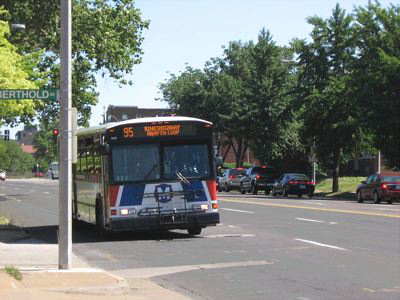No Light Rail in Vancouver!
Another Light-

The head of St. Louis’s transit agency, Larry Salci, says he doesn’t care what transit riders or taxpayers think about him. All he cares is what his board of directors thinks. Oh, yes, and he cares about what his headhunter thinks in case he has to get a new job.

Although using light-
Flickr photo by lordsutch.
Of course, considering that he has been earning $225,000 a year, plus at least $25,000 a year in bonuses, plus a $4,800 a year “vehicle allowance” so he never actually has to set foot on a transit vehicle except for a photo op (and only reluctantly then), he probably has enough to retire now. (Something to think about this Labor Day: Why are transit agency heads often paid more than mayors and even governors?)
So how well is Metro, St. Louis’s transit agency, doing? In 2000, its buses and 17-
Of course, light-
Metro hired Larry Salci in 2002 and asked him to “streamline” its operations. By
2005, he had cut bus service (measured in vehicle revenue miles) by 8 percent and
light-
(All these numbers are from the transit profiles for Bi-

Flickr photo by St.Louis Photoblogger.
Meanwhile, Metro was building a new light-
The legal fees alone are expected to cost the loser (who will probably have to pay the winning party’s costs) well over a million dollars. The trial began two weeks ago and spectators counted more than 40 lawyers representing the various parties in the case. Workers had to remodel the courtroom to make room for all the lawyers and to expand the jury box to accommodate eight alternate jurors (instead of the usual 2) needed for a case that is expected to last through November.
In court, Salci admitted he had never read the contracts his agency had signed with the contractors and had never read the evaluations his staff had done of the companies’ work.
“The only people I really care about that have an input with me are my 10 commissioners
that hired me, and I care what Wall Street thinks about me, and I care what my headhunters
care about in the case I have to go somewhere else,” a lawyer for one of the contractors
quoted Salci as saying in a pre-
I suppose that not caring explains why Salci is known for having an “abrasive” style that leads some local transit advocates to call him an “asshole.” All he has to do, in his mind, is “dazzle” his board and they will keep paying him the big bucks.
Problems with overpaid CEOs can certainly be found in the private sector. But their boards of directors will often toss them if they don’t perform, as Disney’s Michael Eisner learned. And even if they don’t, the only losers are the stockholders, not taxpayers in general.
This should just be one more lesson that transit agencies should not undertake expensive,
long-
Trackback • Posted in Planning Disasters, Transportation, Urban areas
0
Reprinted from The Antiplanner